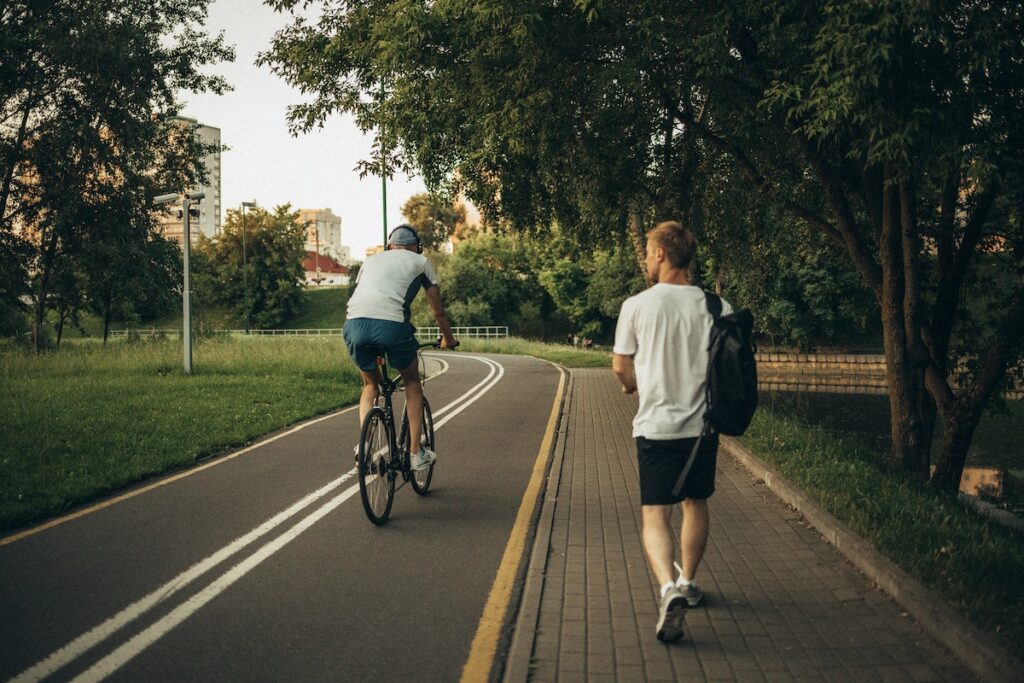Are you looking to shed some pounds and improve your overall fitness? If so, walking and biking are two popular and accessible options. But which one is better for weight loss?
In this article
- What are the benefits of cardiovascular exercise for weight loss?
- What are the benefits of walking for weight loss?
- What are the benefits of biking for weight loss?
- Which burns more calories?
- Which burns more fat?
- Which works muscles better?
- Which builds more strength?
- So, which is better for weight loss?
- Frequently Asked Questions
Cardiovascular exercise is a key component in any weight loss journey. However, when it comes to choosing between walking or biking, there are several factors to consider such as accessibility, convenience, personal preference, and safety.
In this article, we’ll take a closer look at both options and help you decide which one may be more effective for achieving your weight loss goals.
What are the benefits of cardiovascular exercise for weight loss?
Cardio exercises, like walking or biking, are essential for weight loss and can provide numerous benefits for overall health. When you engage in cardio exercise, your heart rate increases, which means that your body burns more calories than when you are at rest. This increase in calorie burn leads to a reduction in body fat, which ultimately results in weight loss.

Aside from its impact on weight loss, cardio exercise also has many other health benefits. For example, it can improve cardiovascular health by strengthening the heart muscle and reducing blood pressure.
It can also boost mood by releasing endorphins that make you feel good. Overall, engaging in regular cardio exercise like walking or biking is an excellent way to achieve your weight loss goals while improving your overall health and well-being.
What are the benefits of walking for weight loss?
Walking is a low-impact form of exercise that can help you lose weight, improve your overall health, and boost your mood. Here are two good reasons why walking is good exercise:
- It’s easy to incorporate into your daily routine: You don’t need any special equipment or training to start walking for weight loss. Simply put on a pair of comfortable shoes and hit the road! You can increase your daily calorie burn by strolling through scenic paths while listening to your favorite songs.
- It’s gentle on your joints: Unlike running or high-intensity workouts, walking puts less stress on your knees, hips, and other joints. This makes it an ideal form of exercise for people who have arthritis or other conditions that affect their mobility.
[Related: 2 Clever Ways to Walk off 25 Pounds in 30 Days]
What are the benefits of biking for weight loss?
Not only does biking help burn calories, but it also strengthens muscles in your legs, core, and arms. This low-impact exercise is perfect for individuals who are looking for an alternative to running or jogging.
One of the biggest benefits of biking is that it can be done outdoors, which makes it a great way to enjoy nature and get some fresh air while working out. Additionally, cycling can be done alone or with friends and family, creating opportunities for socialization and bonding.
Which burns more calories?
We already know that walking and biking are great ways to burn calories, but which one burns more? Well, the short answer is that biking burns more calories than walking. This is because biking requires more energy from your body due to the movement of your legs and the added resistance from pedaling.
According to a study by Harvard Health Publishing, a 155-pound person can burn around 260 calories in 30 minutes of moderate-intensity bike riding, while only burning around 140 calories in 30 minutes of brisk walking.
Which burns more fat?
While both walking and biking can help you shed unwanted pounds, one may be more effective than the other depending on various factors such as intensity level, duration of workout, and your personal fitness level.
Biking tends to burn more calories per hour than walking due to its higher intensity level and larger muscle groups being used. This means that biking can also lead to a greater amount of fat loss over time.
However, if you’re just starting out on your weight loss journey or have physical limitations, walking may be a better option for gradual progress and reducing the risk of injury.

Which works muscles better?
Maximizing muscle engagement can lead to more effective and efficient fitness routines. When it comes to walking or biking for weight loss, understanding which activity works muscles better can make all the difference. Here are five things to consider when deciding between walking and biking:
- Biking engages the glutes, hamstrings, quads, calves, and core muscles.
- Walking mainly works the leg muscles (hamstrings, quads, calves) but also engages the core and arms if you swing them while walking.
- Biking at a moderate intensity burns more calories than walking at a moderate pace.
- Walking uphill is an excellent way to engage your glutes and hamstrings more intensely than regular walking.
- Biking on hilly terrain challenges your legs’ endurance and helps build strength.
If you’re looking for an activity that works for multiple muscle groups simultaneously while burning more calories overall, then biking may be the better option for you.
Which builds more strength?
Building strength through exercise is crucial for overall health and fitness, but when it comes to biking vs walking, which one is better? Here are three things to consider:
- Both biking and walking can help build leg muscles, but biking may be more effective in targeting specific muscle groups like the glutes and hamstrings due to the resistance of pedaling against a gear system.
- On the other hand, walking can also improve upper body strength as well as core stability since it requires good posture and balance.
- Ultimately, the effectiveness of either activity for building strength depends on factors such as intensity level, duration, and frequency of exercise.
So, which is better for weight loss?
You want to shed those unwanted pounds and feel confident in your own skin, right? Well, both walking and biking can help you achieve that goal! However, which one is better for weight loss depends on various factors such as intensity, duration, and frequency.
In general, biking burns more calories per hour than walking because it requires more effort from your muscles. However, if you walk briskly or uphill, you can burn almost as many calories as cycling at a moderate pace.
Additionally, the impact of walking may be easier on your joints compared to the repetitive motion of biking. So you may want to consider these factors. Here’s a table of comparison for walking and biking.
| Walking | Biking |
|---|---|
| Low-impact | High-intensity cardio |
| Easy accessibility | Requires equipment (bike) |
| Can be done indoor/outdoor | Mainly outdoor activity |
| Burns fewer calories per hour | Burns more calories per hour |
| Slower pace | Faster pace |
Safety considerations
Before setting out on a fitness journey, it’s crucial to prioritize safety factors like proper gear and precautions. When it comes to walking or biking for weight loss, safety considerations can vary depending on the location and time of day.
For example, if you plan to walk or bike alone at night, wearing reflective clothing and carrying a flashlight can increase your visibility to drivers. Additionally, choosing well-lit routes with minimal traffic may also reduce potential risks.
Another important safety consideration when walking or biking is protecting yourself from the sun’s harmful rays. Wearing sunscreen with an SPF of 30 or higher and a hat that shades your face can help prevent skin damage and reduce your risk of developing skin cancer.
Finally, always remember to stay hydrated by carrying water with you or planning routes that have access to water fountains along the way. Prioritizing these safety considerations will not only improve your experience but also ensure a healthier outcome in the long run.
Frequently Asked Questions
How many calories do you burn when walking or biking for weight loss?
When I walk or bike for weight loss, I burn calories and feel great. On average, walking at a moderate pace can burn around 300 calories per hour, while biking can burn up to 600 calories per hour. It’s all about finding what works best for you!
Is it better to walk or bike in the morning or evening for weight loss?
For weight loss, it’s best to go for a walk or bike ride in the morning. It jumpstarts metabolism and sets a healthy tone for the day. But anytime is good as long as you’re consistent and motivated!
How long should you walk or bike for weight loss?
To lose weight, I aim to walk or bike for at least 30 minutes a day. This helps me burn calories and improve my cardiovascular health. It’s important to find an activity that you enjoy and can stick with consistently.
Can walking or biking alone help you lose weight or do you need to combine it with other exercises?
Walking or biking alone can help with weight loss, but combining it with other exercises is more effective. Strength training and high-intensity interval training are great additions to a workout routine for maximum results.
How can you prevent injuries when walking or biking for weight loss?
To prevent injuries when walking or biking for weight loss, I always warm up and stretch before starting. I also wear proper footwear and make sure to maintain good posture while exercising. It’s important to listen to your body and take breaks when needed.
Conclusion
Overall, both walking and biking are great options for weight loss. They each offer numerous benefits, such as increasing cardiovascular fitness, burning calories, and promoting overall health. Choosing between the two ultimately comes down to personal preference and lifestyle factors.
For those who enjoy being outdoors and prefer a low-impact exercise option, walking may be the way to go. It’s also a convenient option for those who don’t have access to a bike or live in urban areas.
On the other hand, biking offers a high-intensity workout that can cover more distance in less time. It may be more appealing for those looking for a challenge or who have joint issues that make walking difficult.
Regardless of which one you choose, incorporating regular physical activity into your routine is key to achieving and maintaining weight loss goals. It’s important to find an exercise that you enjoy and can stick with long-term to see the most significant results.
So, lace up your sneakers or hop on your bike and start moving towards a healthier lifestyle today!
Key Takeaways
- Biking burns more calories than walking due to engaging more muscle groups and higher intensity.
- Walking may be a better option for gradual progress and reducing the risk of injury.
- The best exercise for weight loss is the one that you enjoy doing consistently and fits into your lifestyle.
- Both activities can help build strength, but effectiveness depends on intensity, duration, and frequency of exercise.
- Walking is a low-impact, accessible exercise that can be easily incorporated into daily routines without special equipment.
- Biking provides higher intensity cardio and burns more calories per hour, but requires more planning and equipment.
- Consistency is key in maintaining an active lifestyle for weight loss, regardless of the chosen exercise.
- Safety considerations, such as proper gear and precautions, as well as sunscreen and hydration, are important for overall health during exercise.
